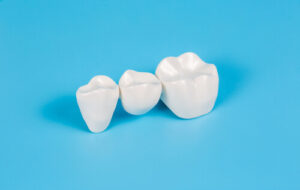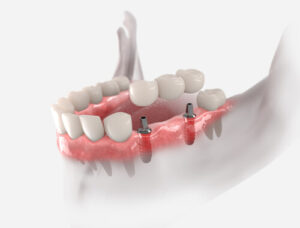Fixed Partial Denture: Understanding Its Benefits
Are missing teeth taking a toll on your confidence and oral functionality? Look no further than the transformative solution known as the fixed partial denture. This remarkable dental prosthesis combines the best aesthetics and function to restore your smile and improve your quality of life.
This article will explore the world of fixed partial dentures, their benefits, drawbacks, and everything in between. So, get ready to discover the key to a restored, beautiful smile with a fixed partial denture.
What are Fixed Partial Dentures?
Bridges, often referred to as fixed partial dentures, are dental prostheses used to replace one or more lost teeth. They are referred to as “fixed” because they provide a stable and long-lasting solution since they are permanently affixed to nearby teeth or dental implants. The patient cannot remove them, in contrast to detachable dentures.
The natural color and form of the patient’s teeth are precisely matched throughout the creation of fixed partial dentures, guaranteeing a smooth and aesthetically beautiful dental function and appearance restoration. In addition to improving oral functioning, this dental treatment is essential for keeping neighboring teeth aligned and maintaining general oral health.
Types of Fixed Partial Dentures: Materials and Designs
Fixed partial dentures, a key dental solution for replacing missing teeth, offer a blend of aesthetic appeal and functionality. They are artificial teeth anchored to adjacent teeth or dental implants designed to bridge the gaps in a patient’s smile. These prosthetics vary in materials and designs, catering to diverse dental needs and preferences.
Materials and Designs:
- Traditional Fixed Bridges: Typically made from porcelain fused to metal or ceramics, these bridges use crowns on the abutment teeth to support the replacement teeth.
- Cantilever Bridges: Used when adjacent teeth are on only one side of the missing tooth or teeth. These are less common and are not recommended for the back of the mouth, where they can put too much force on other teeth.
- Maryland Bridges: Also known as resin-bonded bridges, they are ideal for replacing front teeth. This type involves a metal or porcelain framework bonded to the backs of the adjacent teeth.
- Implant-Supported Bridges: For multiple missing teeth, these bridges are supported by dental implants rather than being anchored to existing teeth. Each implant holds one artificial tooth, making it a sturdy and long-lasting solution.
- Materials: The choice of materials includes porcelain, ceramics, gold, alloy, or a combination. The selection depends on the missing tooth’s location, the teeth’ function, and aesthetic considerations.
- Precision Attachments and Non-Rigid Connectors: Used in certain complex cases to allow for movement or to manage the forces exerted on the teeth.
The Procedure: Steps Involved in Getting a Fixed Partial Denture
Getting a fixed or removable partial denture, a restorative solution for missing teeth involves several precise and critical steps. This procedure not only aims to restore the aesthetics and functionality of the teeth but also ensures the long-term health of the oral cavity.
Detailed Procedure Steps:
- Initial Consultation: The treatment begins with a detailed examination by the Advanced Dental Care dentist in Dubbo, discussing the patient’s needs and evaluating the health of the remaining teeth and gums.
- Treatment Plan: The dentist devises a personalized treatment plan, which may include addressing any preliminary oral health problems like gum disease or tooth decay.
- Tooth Preparation: Abutment teeth adjacent to the gap are reshaped to receive crowns supporting the fixed partial denture.
- Impression Making: An accurate mold of the teeth and gums is taken to ensure the fixed partial denture fits perfectly in the mouth.
- Temporary Solution: A temporary bridge may protect the exposed teeth and gums while the permanent fixed partial denture is being crafted.
- Fabrication: The dental laboratory custom-makes the fixed partial denture, ensuring it matches the color, shape, and size of the natural teeth.
- Fitting and Adjustment: Once ready, the dentist fits the fixed partial denture, making necessary adjustments to ensure comfort and proper bite alignment.
- Final Cementing: The fixed partial denture is permanently attached to the abutment teeth, ensuring it remains securely in place.
Advantages of Choosing Fixed Partial Dentures
 Choosing fixed partial dentures has several advantages, particularly for people looking for a long-lasting and aesthetically beautiful way to replace lost teeth. These metal partial dentures are designed to blend seamlessly with existing teeth, providing a natural look while restoring dental functionality.
Choosing fixed partial dentures has several advantages, particularly for people looking for a long-lasting and aesthetically beautiful way to replace lost teeth. These metal partial dentures are designed to blend seamlessly with existing teeth, providing a natural look while restoring dental functionality.
Improved Aesthetics and Confidence:
Fixed partial dentures are meticulously crafted to emulate the natural appearance of teeth. To ensure a smooth integration into the smile, every flexible partial denture is built to precisely match the patient’s natural teeth in size, color, and form. This attention to detail in aesthetics enhances the overall appearance and significantly boosts the individual’s self-confidence. Patients often report a renewed sense of self-esteem, as their new smile closely resembles their natural teeth, eliminating any self-consciousness associated with missing teeth.
Enhanced Functionality:
The primary function of fixed partial dentures is to restore the mouth’s full functionality. They effectively enable patients to chew and speak with ease, functions that are often compromised due to tooth loss. By restoring the structural integrity of false teeth and the dental arch, these dentures facilitate a normal bite and speech pattern, allowing individuals to enjoy a wider range of foods and communicate more effectively.
Prevention of Teeth Shifting:
Fixed partial dentures play a crucial role in maintaining the alignment of the remaining teeth. When a tooth is lost, the adjacent teeth can shift towards the gap to replace missing teeth, leading to misalignment issues. By filling these gaps, fixed partial dentures prevent such shifting, thereby preserving the proper alignment and bite, which is essential for jaw health and the prevention of further dental complications.
Durability and Reliability:
Constructed from high-quality materials like porcelain, ceramics cast metal, or a combination with metal for added strength, fixed partial dentures are built to endure the rigors of daily use. They are designed to withstand the forces exerted during chewing and speaking, making them a reliable and long-term solution for tooth replacement.
Preservation of Facial Structure:
The presence of teeth plays a significant role in supporting the facial muscles and maintaining the face’s natural contour. Loss of teeth can lead to the sagging of facial muscles and a sunken appearance. Fixed partial dentures help preserve the face’s natural shape by providing the necessary support to facial muscles, thus preventing premature aging signs due to tooth loss.
Ease of Maintenance:
Unlike removable dentures, fixed partial dentures are permanently affixed and do not require removal for cleaning, simplifying the maintenance routine. They can be cleaned like natural teeth with regular brushing, flossing, and mouthwash, making them a convenient option for daily oral hygiene.
No Need for Adhesives:
Since fixed partial dentures are securely anchored to adjacent teeth or implants, they eliminate the need for adhesives, often required for removable dentures. This permanent attachment provides security and comfort, as patients don’t have to worry about their dentures slipping or moving out of place.
Bone Preservation:
In cases where dental implants support fixed or partial dentures, they contribute significantly to the preservation of the jawbone. Implants act as a replacement for tooth roots, stimulating the bone and preventing the bone loss that typically occurs with tooth loss. This preservation of bone structure is crucial for maintaining oral health and the integrity of the facial structure.
Maintenance and Care for Your Fixed Partial Denture
Proper fixed partial dentures maintenance and care are crucial for longevity and effectiveness. These dental prosthetics require specific hygiene practices to remain functional and aesthetically pleasing while contributing to oral health.
Maintenance and Care Tips:
- Regular Brushing: Just like natural teeth, fixed partial dentures must be brushed at least twice daily to remove plaque and prevent bacteria buildup.
- Flossing Techniques: Special flosses and interdental brushes are available to clean around the fixed partial denture, particularly under the pontic (false tooth) and around the abutment teeth.
- Avoiding Hard Foods: It’s advisable to avoid or be cautious with hard and sticky foods that can damage the denture or the abutment teeth.
- Routine Dental Check-ups: Routine visits to the dentist are essential for professional cleaning and to check the condition of the fixed partial denture and surrounding gums and teeth.
- Use of Antimicrobial Mouthwash: Incorporating an antimicrobial mouthwash into the daily routine can help reduce bacteria and maintain oral hygiene.
- Preventing Staining: Be mindful of foods and beverages that stain the denture, such as coffee, tea, and red wine. Regular cleaning can help minimize these effects.
- Handling with Care: While cleaning or inspecting the denture, handle it gently to avoid bending or damaging the structure.
- Immediate Attention to Discomfort: If discomfort, looseness, or change in fit, it’s important to visit the dentist immediately for adjustments.
Potential Challenges and Solutions with Fixed Partial Dentures

While fixed partial dentures are a popular and perfect solution for replacing missing teeth, they can present certain challenges. Understanding these potential issues and their solutions is essential for patients to ensure the longevity and functionality of their dentures.
Challenges and Solutions:
- Oral Hygiene Difficulties: Fixed partial dentures require meticulous cleaning, as trapped food particles can lead to plaque buildup and gum disease. Solution: Regular brushing, flossing with special aids, and antimicrobial mouthwashes can mitigate this risk.
- Wear and Tear: Fixed partial dentures can experience wear over time, which might affect their fit and function. Solution: Routine dental check-ups enable early detection and repair of wear and tear.
- Tooth Decay and Gum Disease: The surrounding teeth supporting the denture are susceptible to decay and gum disease if not properly maintained. Solution: Maintaining rigorous oral hygiene and seeking prompt treatment at the first sign of trouble are key preventive measures.
- Discomfort and Adjustment Issues: Some patients may experience discomfort or difficulty adjusting to their new dentures. Solution: Follow-up appointments with the dentist can address these issues through adjustments or refinements in the denture.
- Aesthetic Concerns: Over time, the color of the denture may not match the natural teeth due to staining or natural teeth color change. Solution: Regular cleaning and professional whitening of natural teeth can help maintain a uniform appearance.
- Structural Damage: Fixed partial dentures can become damaged due to accidents, hard foods, or improper care. Solution: Avoiding hard foods and using a mouthguard during sports can prevent damage. If damage occurs, visiting the dentist for repair is crucial.
- Bone Loss Over Time: Bone loss in the jaw can occur under the denture, affecting its fit and comfort. Solution: Implant-supported dentures can help preserve bone, and regular dental check-ups can monitor and address bone health.
Comparing Fixed Partial Dentures with Other Dental Restoration Options
When it comes to dental restoration for replacing missing teeth, patients have several options, each with advantages and limitations. Comparing fixed partial dentures with alternatives like dental implants, a removable denture, partial dentures, and full dentures is crucial for making an informed decision that aligns with one’s dental needs and lifestyle preferences.
- Fixed Partial Dentures vs. Dental Implants: Fixed partial dentures are less invasive and often more cost-effective than dental implants. However, implants provide superior stability and prevent bone loss, as they are anchored directly into the jawbone. Implants also don’t require alteration of adjacent teeth, a necessity for fixed partial dentures.
- Fixed Partial Dentures vs. Removable Partial Dentures: Fixed partial dentures offer a more permanent solution and typically provide better comfort and function than removable ones. Removable dentures can be easier to clean and are initially less expensive, though they might require more adjustments and replacements over time.
- Fixed Partial Dentures vs. Full Dentures: Full dentures are used when most or all teeth are missing, whereas fixed partial dentures are suitable for one or several missing teeth. Full dentures can be more affordable but may offer a different natural feel and stability than fixed partial dentures.
- Material Differences: The materials used in fixed partial dentures, like porcelain or ceramic, often provide a more natural appearance than the acrylic used in full and removable partial dentures.
- Longevity and Durability: While fixed partial dentures are durable, dental implants can last longer and do not require the alteration of neighboring teeth.
- Oral Health Impact: Fixed partial dentures can strain adjacent teeth and require good oral health for support, while dental implants can help preserve jawbone integrity and don’t rely on neighboring teeth.
In conclusion, a fixed partial denture, or a dental bridge, is an excellent solution for individuals struggling with missing teeth. This dental prosthesis offers numerous benefits, including improved oral functionality, enhanced aesthetics, and better oral health. Patients can regain the confidence to speak, chew, and smile comfortably by replacing missing teeth with a fixed bridge or partial denture. Additionally, this treatment option can aid by preventing other dental problems like misalignment and bone loss. A fixed partial denture can be the best option if you’re getting new teeth to restore your smile and maintain long-term dental health.
References
Fixed Partial Denture – an overview | ScienceDirect Topics
https://www.sciencedirect.com/topics/nursing-and-health-professions/fixed-partial-denture
The fit of zirconia fixed partial denture: a systematic review
https://pubmed.ncbi.nlm.nih.gov/20557435/
with a conventional fixed partial denture (bridge)
https://partially-dentate.fdiworlddental.org/treatment/conventional-fixed-partial-denture-bridge
Endocrown fixed partial denture: Is it possible?
https://www.thejpd.org/article/S0022-3913(23)00052-5/fulltext
Partial Dentures: Cost, Types, and How to Choose
https://www.healthline.com/health/dental-and-oral-health/partial-denture

